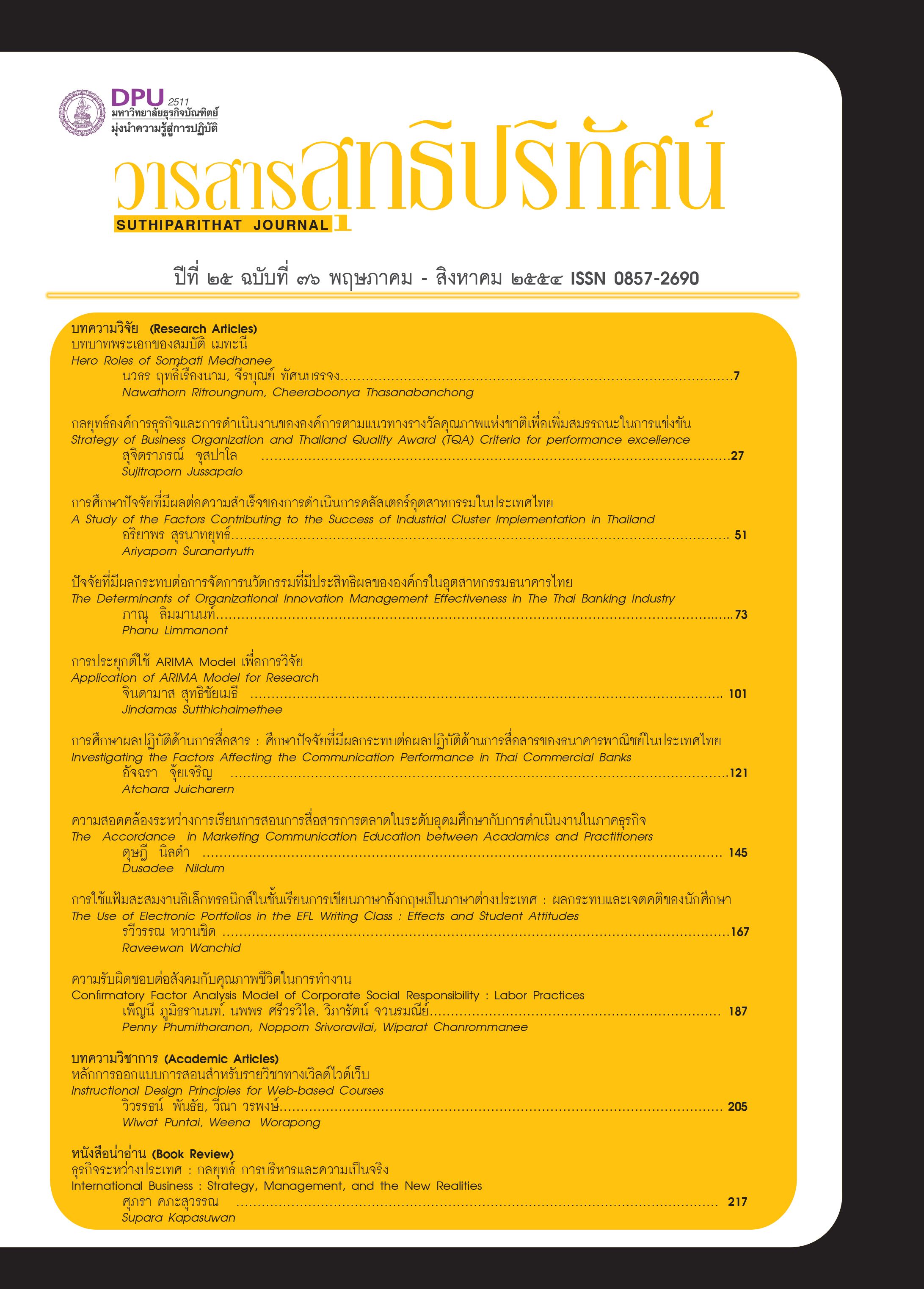การประยุกต์ใช้ ARIMA MODEL เพื่อการวิจัย
คำสำคัญ:
ตัวแปรโครงสร้าง, ข้อมูลอนุกรมเวลา, แบบจำลองที่ดีที่สุดบทคัดย่อ
บทความนี้มีวัตถุประสงค์เพื่อสร้าง The Best Model โดยประยุกต์ ARIMA Model กับตัวแปรโครงสร้าง (Structure Variable) เรียกว่า ARIMAX Model ตามขั้นตอนของ Statistics Model และสามารถนำแบบจำลองดังกล่าวไปใช้สำหรับการพยากรณ์ให้เกิดประสิทธิภาพสูงสุดด้วย
จากการศึกษาข้อมูลในระบบเศรษฐกิจมหาภาคพบว่า ส่วนมากข้อมูลเหล่านี้ จะมีลักษณะเป็น Non Stationary และเพื่อให้การพยากรณ์ให้เกิดประสิทธิภาพสูงสุด ในการศึกษาจึงได้ปรับข้อมูลให้มีลักษณะเป็น Stationary และถ้าข้อมูลมี Cointegration กันจำเป็นอย่างยิ่งที่จะต้องนำค่า Error Correction Mechanism (ECM) ประกอบไว้ในแบบจำลองนั้นๆ และจากผลการศึกษาพบว่า การสร้างตัวแบบที่ดีที่สุดนั้น (The Best Model) จะต้องมีการเลือกแบบจำลองประมาณค่าให้ถูกต้องและเหมาะสมกับประเภทของข้อมูลนั้นๆ ซึ่งส่งผลให้การพยากรณ์เกิดความคลาดเคลื่อนต่ำและ สามารถนำมาใช้ประโยชน์ได้อย่างถูกต้องต่อไป
เอกสารอ้างอิง
จินดามาส สุทธิชัยเมธี. วิเคราะห์ความได้เปรียบโดยเปรียบเทียบและอุปสงค์การนำเข้ายางพาราจากประเทศไทยในตลาดจีน. งานวิจัย, 2549พฤทธ์สรรค์ สุทธิไชยเมธี. สถิติและการวิเคราะห์เชิงปริมาณ. พิมพ์ครั้งที่ 1, กรุงเทพฯ : บริษัทจามจุรี จำกัด, 2553.
พฤทธ์สรรค์ สุทธิไชยเมธี. สถิติและการวิเคราะห์เชิงปริมาณขั้นสูง. พิมพ์ครั้งที่ 1, กรุงเทพฯ: สำนักพิมพ์ดวงแก้ว , 2553.
พฤทธ์สรรค์ สุทธิไชยเมธี. เศรษฐมิติประยุกต์เพื่อการวิจัย. พิมพ์ครั้งที่ 1, กรุงเทพฯ: สำนักพิมพ์ดวงแก้ว , 2553.
พฤทธ์สรรค์ สุทธิไชยเมธี. (2553) วิเคราะห์แนวโน้มการส่งออกยางพาราของประเทศไทยไปตลาดจีน งานวิจัย. ทุนวิจัยวิทยาลัยเทคโนโลยีสยาม.
Anderson, O.D., “Time Series Analysis and Forecasting – The Box – Jenkins Approach,” Butterworths, London, 1975.
Box, George and D. Piece. “Distribution of Autocorrelations in Autoregressive Moving Average Time Series Models.” Journal of the American Statistical Association 65 (1970), 1509-26
Dickey, D. A., “Likelihood Ratio Statistics for Autoregressive Time Series with a Unit Root”, Econometric (March 1987), 1981, 251-76
Dickey, and W.A. Fuller (1979),”Distribution of the Estimators for Auto–Regressive Time Series with a Unit Root”, journal of American Statistical Association, 74 , pp.427-431.
Drapper, N.R, and Smith, H., “Applied Regression Analysis,” 2nd Edition, John Wiley & Sons, New York,1981.
Granger, Clive and P. Newbold. “Spurious Regressions in Econometrics.” Journal of Econometrics 2 1974, 111-20.
Granger, E.S., JR. and Mckenzie ED. “Forecasting Trends in Time Series.” Management Science Vol 31 . 10 (October 1985) : 1237-46
Johansen, S. and K. Juselius , “Maximum Likelihood Estimation and Inference on Co-integration: With Applications to the Demand for Money.” Oxford Bulletin of Economics and Statistics 52 (February 1990)”, 1990.
Kolb, R.A. and Stekler, H.O., “Are Economic Forecasts Significantly Better Than Naïve Predictions ? An Appropriate Test,” International Journal of Forecasting, Vol.9, 1993, pp. 117 – 120.
Makridakis, S., The accuracy of major extrapolation (time series) method. J. of Forecasting., 1: 1982, 111 – 153.
Montgomery, D.C., Johnson, L.A. and Gardiner, J.S., “Forecasting and Time Series Analysis,” 2nd Edition, McGraw – Hill Inc., New York, 1990.
Nelson, C.R., “Applied Time Series Analysis for Managerial Forecasting” Holden Day, San Francisco, 1973
Newbold, P. and Granger, C.W.J., “Experience with Forecasting Univariate Time Series and the Combination of Forecast,” Journal of Royal Statistical Society A,Vol,137, 1974, pp.131 – 146
Willeam W.S. Wei. Time Series Analysis : Univariate and Multivariate method. New York USA: Addison – Wesley Publishing company, 1990.
ดาวน์โหลด
เผยแพร่แล้ว
รูปแบบการอ้างอิง
ฉบับ
ประเภทบทความ
สัญญาอนุญาต
เนื้อหาและข้อมูลในบทความที่ลงตีพิมพ์ในวารสารสุทธิปริทัศน์ ถือเป็นข้อคิดเห็นและความรับผิดชอบของผู้เขียนบทความโดยตรงซึ่งกองบรรณาธิการวารสาร ไม่จำเป็นต้องเห็นด้วย หรือร่วมรับผิดชอบใด ๆ
บทความ ข้อมูล เนื้อหา รูปภาพ ฯลฯ ที่ได้รับการตีพิมพ์ในวารสารสุทธิปริทัศน์ ถือเป็นลิขสิทธิ์ของวารสารสุทธิปริทัศน์หากบุคคลหรือหน่วยงานใดต้องการนำทั้งหมดหรือส่วนหนึ่งส่วนใดไปเผยแพร่ต่อหรือเพื่อกระทำการใด ๆ จะต้องได้รับอนุญาตเป็นลายลักษณ์อักษรจากวารสารสุทธิปริทัศน์ก่อนเท่านั้น







